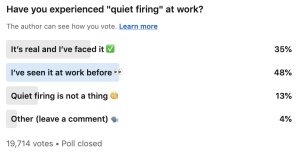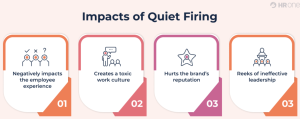The chances are, you won’t know who Justin Garrison is.
Here he is, just in case you want to see what he looks like.

He’s not a film star you ought to know, or a politician, or a sportsman.
In fact, he’s a pretty ordinary sort of chap, albeit one who’s had a fair bit of success in his work.
He’s a developer who works in the cloud. In previous roles he’s helped create Oscar-winning movies, built Disney+ and (at the moment), he’s with Amazon Web Services – the retail giant’s cloud computing subsidiary.
I say at the moment because Garrison sensationally claims: “Amazon won’t fire me.”
Normally that’s a good thing, but not in his book – because he claims Amazon is deliberately ‘silent sacking’ him and hundreds of other employees – that is making his life so intolerable that eventually he and other colleagues will simply up-sticks and go rather than be granted the severance pay and other benefits that would normally expect if he and others were ‘properly’ laid off.
These accusations were startling made in his most recent blog – “Amazon’s Silent Sacking” [posted on 30th December], where he claims that rather than being officially laid off after being told “my team and an adjacent team were being eliminated,” HR was pursuing a policy of finding him ever-more unappealing jobs that would force him to quit himself.
Troubles that started last autumn:

According to Garrison, issues started last September, when he was told his role and team would be eliminated.
“They [his manager and VP] claimed we all did such good work that they wanted us to remain at Amazon. ‘We still have a job, just not a role’,” he wrote. Severance would only be considered, his managers told him, once all other options had been exhausted.
“It was clear they wanted us to take a different role we could quit later,” he says. “My management wanted to retain the headcount, but couldn’t do layoffs.”
Says Garrison: “Every week for the next 2 1/2 months I asked for an update on my employment and severance package. I was either ghosted or given a variety of excuses. It’s now December 30th and I’m currently still employed by Amazon.
“It hasn’t only been happening to my team. This has been happening in multiple areas as Amazon silently sacks people without being required to give them severance or announce layoffs.”
Layoffs spook markets
According to Garrison, instead of mass layoffs – that inevitably have a share-price impacting effect – Amazon wants to makes people’s lives enough of a misery that they’ll quit for them.
“How could they force people to leave without severance packages or en masse?” he writes. “Making them miserable and silently sacking them.”
He argues that even before eliminating his team it started with enforcing return to office (RTO) mandates. “RTO was enforced. And people started leaving in droves,” he recalls. “Many teams at Amazon have been in a hiring freeze for over a year. And now they’re chasing away the people they do have,” he continues.
He adds: “Many of the service teams have lost a lot of institutional knowledge as part of RTO. Teams were lean before 2023, now they’re emaciated. Teams can’t keep innovating when they’re just trying to keep the lights on.”
Is ‘silent sacking’ really a thing?
So how should CHROs interpret this?
Read at face value, Garrison’s claims can either be regarded as the unhappy grumblings of a disengaged employee; someone merely giving his own view of a very one-sided story.
But, it could also be viewed as an insight into a corporate tactic that’s alive and well, and seemingly going to feature more in the coming year ahead. As he also writes: “I’ve heard similar tactics being used at other companies – mostly large companies – and it’ll only continue in 2024 as they make decisions that drive short term profits over all else.”
So which is it?
According to Business Insider – which has also been following the story, since posting his blog Garrison says he’s received messages from people across Amazon who said his post resonated with their position.
“I haven’t had a single person at Amazon who said I was wrong,” Garrison said. “Every single one of them was like, ‘Yep, this is exactly what we’ve been living through and it sucks.’”
The dangers of actively pursuing silent sacking
According to Jim Moore, employee relations expert at HR consultants Hamilton Nash, deliberately creating intolerable conditions to reduce head count is – thankfully “not a common practice.”
However, a recent poll revealed 83% of employees said they’d observed quiet firing/silent sacking in action, while 35% said they’d experienced it firsthand.

Speaking to TLNT he said that if companies are pursuing it, it’s not good.
“The biggest problem with such an approach is that it’s indiscriminate,” he said. “You don’t know who will quit and who will stay.”
He adds: “Leaders also need to remember that there’s the potential for a constructive unfair dismissal claim if an employee could show that an employer deliberately made conditions intolerable to force a resignation.”
But for anyone who still thinks silent sacking is a good idea, he also has this to say:
“Adopting a sweeping ‘If you don’t like it, quit’ approach is irresponsible business leadership. The correct approach would be a genuine redundancy procedure, where a fair selection process can be used to identify the appropriate reductions.”He adds: “Some employers are being tone deaf towards the needs of workers and are resisting embracing the reality of remote and hybrid working. However, in this case, it’s more likely to be poor judgement rather than a cynical ‘silent sacking’ exercise.”

(Source: HROne)
Unintentional or not though, just the suspicion of silent sacking is not a good look for employers to have to deal with.
Garrison clearly thinks that this is what’s going on at Amazon. The reality, of course, could be much different [Amazon has been approached for comment].
Maybe HR’s hands are tied? Maybe there just aren’t roles to move people to?
But even so, there’s a school of thought that says employees should be told about this, rather than be left to make up their own (potentially inaccurate) interpretations themselves.
So if you think your staff suspect there’s silent sacking going on at your organization, maybe now is the time to nip this in the bud, before tensions really start to rise.
